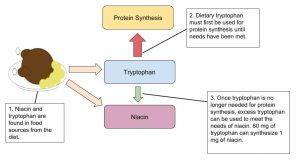Chapter 11: Micronutrients in Metabolism
11.3 Niacin (Vitamin B3)
University of Hawai‘i at Mānoa Food Science and Human Nutrition Program
Niacin (B3)
Niacin is a component of the coenzymes NADH and NADPH, which are involved in the catabolism and/or anabolism of carbohydrates, lipids, and proteins. NADH is the predominant electron carrier and transfers electrons to the electron-transport chain to make ATP. NADPH is also required for the anabolic pathways of fatty-acid and cholesterol synthesis. In contrast to other vitamins, niacin can be synthesized by humans from the amino acid tryptophan in an anabolic process requiring enzymes dependent on riboflavin, vitamin B6, and iron. Niacin is made from tryptophan only after tryptophan has met all of its other needs in the body. The contribution of tryptophan-derived niacin to niacin needs in the body varies widely and a few scientific studies have demonstrated that diets high in tryptophan have very little effect on niacin deficiency. Niacin deficiency is commonly known as pellagra and the symptoms include fatigue, decreased appetite, and indigestion. These symptoms are then commonly followed by the four D’s: diarrhea, dermatitis, dementia, and sometimes death.


Dietary Reference Intakes
The RDAs and ULs for different age groups for Niacin are listed in Table 11.31 “Dietary Reference Intakes for Niacin”. Because niacin needs can be met from tryptophan, the RDA is expressed in niacin equivalents (NEs). The conversions of NE, niacin, and tryptophan are: 1 mg NE = 60 mg tryptophan = 1 mg niacin
Table 11.31 Dietary Reference Intakes for Niacin[1]
| Age Group | RDA Males and Females mg NE/day) | UL |
| Infants (0–6 months) | 2 * | Not possible to establish |
| Infants (7–12 months) | 4* | Not possible to establish |
| Children (1–3 years) | 6 | 10 |
| Children (4–8 years) | 8 | 15 |
| Children (9–13 years) | 12 | 20 |
| Adolescents (14–18 years) | 16 (males), 14 (females) | 30 |
| Adults (> 19 years) | 16 (males), 14 (females) | 35 |
| Pregnancy | 18 | Same as non-pregnant |
| Lactation | 17 | Same as non-lactating |
| *denotes Adequate Intake | ||
Dietary Sources
Niacin can be found in a variety of different foods such as yeast, meat, poultry, red fish, and cereal. In plants, especially mature grains, niacin can be bound to sugar molecules which can significantly decrease the niacin bioavailability. For the niacin content of various foods, see Table 11.32 “Niacin Content of Various Foods”.
Table 11.32 Niacin Content of Various Foods[2]
| Food | Serving | Niacin (mg) | Percent Daily Value |
| Chicken | 3 oz. | 7.3 | 36.5 |
| Tuna | 3 oz. | 8.6 | 43 |
| Turkey | 3 oz. | 10.0 | 50 |
| Salmon | 3 oz. | 8.5 | 42.5 |
| Beef (90% lean) | 3 oz. | 4.4 | 22 |
| Cereal (unfortified) | 1 c. | 5 | 25 |
| Cereal (fortified) | 1 c. | 20 | 100 |
| Peanuts | 1 oz. | 3.8 | 19 |
| Whole wheat bread | 1 slice | 1.3 | 6.5 |
| Coffee | 8 oz. | 0.5 | 2.5 |
- Source: Dietary Supplement Fact Sheet for Health Professionals: Niacin. National Institutes of Health, Office of Dietary Supplements. https://ods.od.nih.gov/factsheets/Niacin-HealthProfessional/. Updated November 18, 2022. Accessed August 2, 2023. ↵
- Micronutrient Information Center: Niacin. Oregon State University, Linus Pauling Institute. http://lpi.oregonstate.edu/mic/vitamins/niacin. Updated in July 2013. Accessed October 22, 2017. ↵
Catabolism refers to catabolic metabolic pathways. Catabolic pathways break down polymers into their monomers, releasing energy
Anabolism refers to anabolic metabolic pathways. Anabolic pathways use energy to build polymers from smaller molecules.
The term bioavailability refers to the proportion or fraction of a nutrient, consumed in the diet, that is absorbed and utilized by the body.
Source - https://journals.sagepub.com/doi/pdf/10.1177/15648265110321S104

